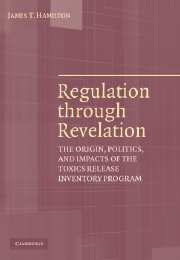 Regulation through Revelation
Regulation through Revelation Book contents
- Frontmatter
- Contents
- Acknowledgments
- Introduction
- 1 Legislating an Incomplete Contract
- 2 Defining Terms: Rulemaking and the Initial TRI Data Release
- 3 Spreading the Word in the Public and Private Sectors
- 4 Politics of Expansion and Contraction
- 5 Life Cycles in the Regulatory Environment
- 6 The Impact(s) of the TRI
- 7 Lessons from and for Regulatory Implementation
- Notes
- Bibliography
- Index
1 - Legislating an Incomplete Contract
Published online by Cambridge University Press: 24 November 2009
- Frontmatter
- Contents
- Acknowledgments
- Introduction
- 1 Legislating an Incomplete Contract
- 2 Defining Terms: Rulemaking and the Initial TRI Data Release
- 3 Spreading the Word in the Public and Private Sectors
- 4 Politics of Expansion and Contraction
- 5 Life Cycles in the Regulatory Environment
- 6 The Impact(s) of the TRI
- 7 Lessons from and for Regulatory Implementation
- Notes
- Bibliography
- Index
Summary
Environmental regulations follow a long paper trail. They start life as a proposed bill in Congress, travel through committee hearings, generate floor debates, and emerge as a final bill passed by the House and Senate and signed by the President. The exact wording of the regulations comes later in a public rulemaking process, though the actual meaning and impact of the rules may depend on future court cases, agency guidance documents, and enforcement decisions by regulators. For the Toxics Release Inventory program, the path from law to regulation runs through an unlikely spot – the Union Carbide plant in Bhopal, India. On the night of December 2–3, 1984, a leak at the chemical plant generated clouds of methyl isocyanate that killed more than 2,000 people. Worldwide media attention generated debates over how to prevent such accidents and exposures. By the end of December 1984, four subcommittees in the U.S. House of Representatives were investigating Bhopal. In 1985, multiple bills were introduced to provide residents with information about what chemicals were used by plants in their neighborhoods. Speakers frequently referred to Bhopal during debate, generating 82 references to the incident in the Congressional Record in 1985–1986. In 1986, Congress finally passed the Emergency Planning and Community Right-to-Know Act (EPCRA), whose implementation gave rise to the regulatory program known as the Toxics Release Inventory program.
- Type
- Chapter
- Information
- Regulation through RevelationThe Origin, Politics, and Impacts of the Toxics Release Inventory Program, pp. 10 - 44Publisher: Cambridge University PressPrint publication year: 2005


